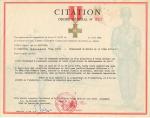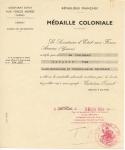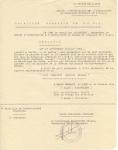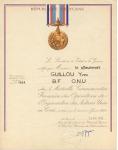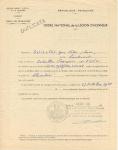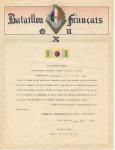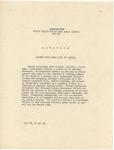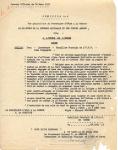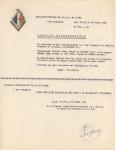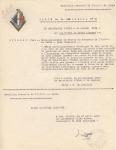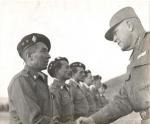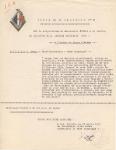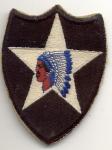-
Posts
2,123 -
Joined
-
Last visited
-
Days Won
4
Content Type
Profiles
Forums
Blogs
Gallery
Events
Store
Everything posted by Paul L Murphy
-

Soviet Advice for a novice?
Paul L Murphy replied to imccrack's topic in USSR: Soviet: Other Militaria
I would be surprised if they were fakes because you can still buy originals by the bucket load in Russia. The going price for one of these in the flea markets in Moscow two years ago was about $5 to a foreigner, ie me. You still see them being worn by Russia army conscripts today, notwithstanding the fact that the symbolism on the buckle is a little outdated ! I would agree with Irish Gunner and pay a maximum of $10 for one that is in good condition and dated. I suspect they are probably still being made since they are definiately still being used by the Russian army. :cheers: -
This is the 8th Class of the Order of the Sacred Treasure. The box is from the Meiji period but the medal is later (Showa period). In other words, the box is from before 1910 but the medal is from the 1930s. The earlier medals had different die details around the size of the central mirror and the size of the arms between the circles that represent jewels. Notwithstanding this you got a good deal. Anything under $30 for this is a very reasonable price. You have now started on a slippery slope ! Japanese orders and medals are very well made and attractive. The cases are actually hand assembled, even though they are mass produced. The Sacred Treasure tended to be used as a long service decoration. The 8th class was awarded to enlisted men after 20 years service, and to low ranking civil servants or public servants (teachers etc) for similar periods of devotion to duty. Even though it is junior to the Order of the Rising Sun it was awarded less. If you want any help putting together a collection of Japanese orders and medals then let me know and I will assist. Cheers, Paul
-
OK, so now I know who got this. I was watching it closely but the bidding went higher than I was prepared to pay, notwithstanding what a great award it is.
-
And if you want to get an example of the medals they earned while they were there then ou need to get the Medaille Colonial with a Maroc or Maroc 1923 bar. Then you will have the complete set.
-
As you said in your second post they are for different periods. The one on the right is for 50s and 60s (up until these North African territories were given their independance). It is very unusual to find it with three bars, you normally find it with one bar and Algeria is the most common. The badge on the left hand ribbon is the unit badge of the 5th Regiment Tirailleurs Marocains (Moroccan Rifle Regiment) and dates from a later period than the medal.
-
Guillou’s politics was right wing and he was one of the founders of the OAS. He took part in the anti-Gaullist coup in 1962 and fled to Franco controlled Spain after its failure. I suspect this is why he never got the campaign medal for Algeria, and why his Croix de Valeur Militaire is added to the group almost as an afterthought (it is pinned in using the original mounting pin rather than being sewn in like the others. Around this time he started to become known by the name Yves Guerin-Serac, instead of his real name. He also used the names Jean-Robert de Guernadec and “Ralph”. The last name was his nickname within Aginter Press (see below). He soon moved to Portugal and worked for the Salazar regime, in particular with their secret police and as an instructor with the Portuguese army’s counter insurgency unit, Legiao Portuguesa. He was quoted in Paris Match of November 1974 as saying “The others have laid down their weapons, but not I. After the OAS I fled to Portugal to carry on the fight and expand it to its proper dimensions - which is to say, a planetary dimension." In 1965 he founded Aginter Press as a front for a secret anti-communist army with support from both the Portuguese secret police (PIDE) and the CIA. Aginter Press set up training camps in which it instructed mercenaries and terrorists in a three-week course in covert action techniques including hands-on bomb terrorism, silent assassination, subversion techniques, clandestine communication and infiltration and colonial warfare. Italian neofascist Stefano Delle Chiaie also participated in the founding of Aginter Press. "During this period", disclosed Guérin-Sérac, "we have systematically established close contacts with like-minded groups emerging in Italy, Belgium, Germany, Spain or Portugal, for the purpose of forming the kernel of a truly Western League of Struggle against Marxism”. On January 31, 1968, Guérin-Sérac met Pino Rauti, then leader of Ordine Nuovo (he would join again the Italian Social Movement (MSI) the next year). In the '70s he was in contact with Leo Negrelli, former chief press attaché in the Italian Social Republic. Aginter Press took part in Italy's “strategy of tension”, a campaign of false flag bombings and an attempted coup d'état organised by the Italian neo-fascists with support from Propaganda Due (P2) and Gladio. It was implicated in the 1969 Piazza Fontana Bombing where a right wing Italian group set off a car bomb and blamed it on anarchists. Guerin-Serac was also viewed as the head of the Portuguese branch of Operation Gladio, a CIA funded plan to create domestic anti-communist cells in Europe who would organise resistance in the event that Europe fell to a Soviet attack. Aginter Press is suspected of having assassinated General Humberto Delgado (1906–1965), founder of the Portuguese National Liberation Front against Salazar's dictatorship (prominent historians and several sources also claim Delgado's assassination was performed by PIDE operational Rosa Casaco), as well as anti-colonialist leader Amilcar Cabral (1924–1973), founder of the PAIGC (African Party for the Independence of Guinea and Cape Verde) and Eduardo Mondlane leader of the liberation movement FRELIMO (Frente de Libertação de Moçambique), in 1969 (prominent historians and several sources also claim Cabral's assassination was performed by individuals within Cabral's guerrilla movement, the PAIGC, and Mondlane's death was work of his enemies inside FRELIMO - according to these versions, both assassinations were the result of struggles for power within the independentist movements) After the 1974 overthrow of the Salazar regimen in Portugal he returned to Franco’s Spain. I have no idea what happened to him after that, or where and when he died. Also apart from the photo of him receiving his Bronze Star I have not been able to find any other photo of him, notwithstanding his notoriety. If anyone is able to add any details to what I have above I would welcome it. I am sure you will all agree it is an amazing group of medals and documents to someone with whom you would not have wanted to cross swords !
-
Guillou was promoted to the rank of Captain with effect from 1st April 1959. At this time he was serving in Calvi with the 1 BPC (Battalion Parachutist de Choc), within the 11 Demi Brigade Parachutist de Choc. Guillou served in Algeria as part of the 11th Demi Brigade Parachutist de Choc. This unit was an elite parachutist unit which served with the French external intelligence service, SDECE. He was awarded the Croix de Valeur Militaire with silver star in May 1961 with the following citation : Commander of a brave commando with a sang-froid on all occasions who distinguished himself in many ways during operations conducted at night. On the night of 16 and 17 April 1961 after having well laid his ground in particularly delicate technical and tactical conditions, he surprised a rebel bivouac at the head of a light group, cut down three rebels, recovered a rifle, two machine pistols and important documents. Thanks to his preparation for the operation and its speed of execution he obtained his results without loss.
-
He received the Colonial Medal with Extreme Orient bar in November 1954 as a Lieutenant in the 1st BPC, and the Indochina War Medal in December 1954. In January 1955 he became commander of the 1st Company 1 BPC. He appears to have taken part in Operation Castor but the 1st Company did not jump at Dien Bein Phu for the siege. They were the only company of the 1 BPC who did not. Here are his certs for the Colonial Medal and Indochina War Medal. He did not receive any bravery awards for Indochina.
-
For good measure here are some more of his Korean related certs (not all, there is loads of paperwork with the group).
-
On 25th September 1953 Guillou was transferred from being a reserve cavalry lieutenant to a regular army infantry lieutenant with effect from 1st August 1953. Guillou qualified as a parachutist at Pau on 3 September 1953, when a lieutenant in the 1st Company 18 RIPC. His document of 25th September is stamped by the 18th Regiment Infanterie Parachutiste de Choc. On 10th October 1953 he was still at Pau with the 1st Company 18 RIPC and received a license to drive military vehicles heavier than 3 tons but he appears to have transferred to the 1st Company of the 1st BPC (Battalion Parachutist Colonial) soon after this. In October 1953 he was awarded the Chevalier of the Legion of Honour for his service in Korea. On 22 October 1953 the French Battalion left Korea and returned to Indochina but by then Guillou was serving with the 1 BPC. After the signing of the armistice in July 1953, the French Battalion left Korea with 5 French Citations to the Order of the Army, the French Fourragère in the colors of the Military Medal, 2 Korean Presidential Citations, 3 American Distinguished Unit Citations and 1898 French war crosses. Their casualties amounted to 287 KIA, 7 MIA, 1,350 WIA and 12 POW. Here is his Parachutist certificate, with the number matching his brevet shown in post #2 above.
-
On 16th October 1952 he had been promoted to Lieutenant. His wound on 20th October was due to shrapnel from a mortar round and he was wounded in the left thigh. He was wounded twice during the war. Guillou received his Korean War Medal in May 1953. He also received the right to wear the Korean Presidential Unit Citation in his personal capacity.
-
From 6-10th October 1952 the French Battalion was involved in the battle to hold Arrow Head Hill, which they did at high cost. For bravery during this action Guillou was awarded the US Bronze Star Medal with V Device and his citation reads as follows : - Second Lieutenant Yves Guillou, Infantry, French Army. Lieutenant Guillou, a member of an infantry battalion, distinguished himself by heroism in action against the enemy in the vicinity of Chorwon, Korea. On the night of 6 October 1952, Lieutenant Guillou’s platoon was occupying defensive positions on a tactically important hill. Without warning, the friendly troops were subjected to a fanatical attack by a numerically superior hostile force. Moving fearlessly through the fire swept area, Lieutenant Guillou directed the defense of the friendly positions as his men fought the foe with grenades, small-arms, bayonets and fists. Frequently endangering his life to evacuate casualties, he so inspired his men that they beat off the hostile attack. The heroism exhibited by Lieutenant Guillou on this occasion reflects great credit on himself and the French Army. For the same period he was also awarded a Croix de Guerre with Bronze Palm. His citation for this reads as follows : - A section commander and magnificent trainer of men, he confirmed this in brilliant fashion during fighting on point 281 from 6th to 20th October in the region of Ch’Orwon, Korea. With his section he was designated to assist during the height of the fighting the 1st company of riflemen who were very heavily engaged and in a situation of near desperation, he traversed with elan through a deadly artillery barrage to retake as quickly as possible the trench which was key to battle. He arrived a few minutes before the first assault wave and was immediately isolated by the bombardment, he enthusiastically organised, on the position pounded by the heavy enemy artillery, an effective defense and firing points against a fanatical enemy enjoying powerful numbers. After a night of fighting he recovered an important armament. At the extreme limit of fatigue he volunteered to counter attach and search for the bodies of his friends temporarily abandoned on the advance post. He conducted himself without thought of his own safety in order to accomplish difficult missions and was wounded at his post on 20th October 1952 and evacuated. An example of dedication and simplicity in executing his role as a leader at war, as well as courage.
-
-
We next see him winning a Divisional level Croix de Guerre and he was awarded the Croix de Guerre with Silver Star for the following actions in July and August 1952 : - A remarkable officer, he has commanded the 3rd Section of the 3rd Company without respite from January to August 1952, both on the Kumhwa front and that of Ch’Orwon. On 16th to 18th July he assured the placing of fortifications on a position that was practically non-existent situated in the Inmong-Myon sector of T-Bone, west of Ch’Orwon. He turned his advance post into an impregnable fortress and dominated his men with his energy and enthusiasm despite the violent bombardments to which his unit was subjected. Charged from 4th to 13th August with the defense of an advanced post situated on point 191, and particularly exposed to the attacks of enemy infantry and artillery, in spite of the intense enemy fire he kept the losses of his section to a minimum due to his excellent fortifications.
-
On 24th April 1952 he was wounded by grenade fragments to the right ear at 3am at Chandj Isan in front of point 1062 in the Kumhwa region. He was serving with the 3rd Company of the French Battalion at this time. The events around this resulted in a second award of the Croix de Guerre with Gold Star. The citation reads : - He particularly distinguished himself on 1st April 1952 at the head of his detachment during a deep night time patrol, in an unknown area behind enemy lines in the region of 1062 Kumhwa. During the course of a similar raid on 24 April 1952 against the enemy position on 252, the village of Changuisan, Kumhwa, he was wounded when placing his men for the assault on a particularly fortified post. He has succeeded in turning his section into a redoubtable instrument of combat due to his exceptional qualities as a commander and soldier. The wound report and C de G citation follows : -
-
Here is a photo of the man in question. He is the one on the left at this medal parade, it is when he received his Bronze Star Medal. A litle bit about Yves Guillou - He was born on 2nd December 1926 in Roudres, France (Dept C du Nord). He joined the army reserve on 1st March 1947 and his military service number was 15,814. From 24th November 1947 to 14th February 1948 he was a student Aspirant at the Cherchell military school and he then completed the reserve officer’s course at the EAABC in Saumer from 23 February 1948 to 26 May 1948. He was promoted to Sergeant on 1st May 1948 and then to Aspirant on 1th June of the same year. He was a platoon commander in the 2 RSA (Regiment Spahis Algerien) from 31th May 1948 to 1st September 1948. He was promoted to 2nd Lieutenant on 1st December 1949. He was placed on active service from 25th August 1951 and arrived in Korea on 26th December 1951. He was appointed as a Chef de Section, ie platoon commander, on 4th January 1952. He was awarded the Croix de Guerre with a Gold Star for the following incidents in early 1952 : - A young section commander recently arrived in the battalion, immediately imposed himself with the true qualities of a commander. Distinguished himself during a difficult patrole on 22 January 1952 in front of point 1062 in the Kumhwa region, he approached enemy positions to find out important information required by the commandant. He volunteered for all the dangerous missions and took part in an effective sortie on 11 February 1952 to enable the disengagement of advance post Paektong-Li which was under attack by a particularly aggressive enemy. He lead a detachment of volunteers charged with attacking point 400 to the North West of Kumhwa, strongly fortified by the enemy, and enabled by his sang froid, his courage and his decisive spirit to succeed on a mission that was particularly dangerous and delicate. The citation follows : -
-
This came with the following insignia. His numbered parachutist wings His French combat diver badge, also numbered on the reverse. His Korean Presidential Unit Citation with his French Battalion beret badge and collar badges. And lastly on the badge front we have his armbadge for the 2nd Infantry Division
-
I was recently able to purchase an amazing group of medals and documents to a real life Dog of War. His real names is Yves Guillou but he was better known as Yves Guerin-Serac. Here is what I got and the bits of his story I have uncovered so far. If anyone out there has more information about him, especially his activites post Korea, please feel free to let me know. First up, his medals. A rahter impressive grouping comprising the Chevalier of the Legion of Honour, A Croix de Guerre TOE with bronze palm, two gold stars and a silver star, Colonial Medal with EO bar, Korean War Medal, Indochina War Medal, Wound Medal, US Bronze Star Medal with V Device, UN Korea Medal and a Croix de Valeur Militaire with silver star. The eagle eyed among you will notice the lack of a medal for North Africa, and the unusual positioning of the Croix de Valeur Militaire, but there is probably a good reason for that as we will see later.
-
It is a certificate from the Imperial Seaman Relief Association. Nice document, and hard to find.
-
A nice untouched piece. It is nice to see these with the bars intact and the hook and eye assembly on the ribbon in place. What sort of price are they going for now if you do not mind me asking ?
-
I have sold to him a twice without any problem thus far. Everything was posted with a tracking number and signature requirement but he advised receipt of the first lot and the second lot of stuff was sent to him last week. His emails are a little abrupt but I put that down to English not being his native language.
-
It is either 30th, 31st or 32nd degree of the Rose Croix (they are very similar badges and only differ in the amount of gilding). I believe I am correct in saying that the Rose Croix is also called the Ancient and Accepted Rite or the Scottish Rite but I may be confusing them. The insignia, however, is definitely masonic and one of these degrees.
-
Yes it is, I corrected myself. I was looking at it too late at night !
-
Dieter, The Order of the Rising Sun with Pawlonia Flowers is superior to the Golden Kite. The only order higher than it is the Order of the Chrysanthemum. Hence why he wears this is preference to the Golden Kite. The order in the centre is the Knight Grand Cross of the Order of the Bath from Britain. He was made an honorary knight after the Russo Japamnese War since Britain and Japan were quasi allies at that time. The medals on his medal bar are the Imperial Constitution Promulgation Medal, Meiji 25th Wedding Anniversary Medal, 1894-95 War Medal, 1904-05 War Medal and Red Cross Special Member's Medal. Regards, Paul
-

Republic of Ireland Irish 1916-20
Paul L Murphy replied to Kev in Deva's topic in Northern European & Baltic States
I struggle with the claims made about some of the items in this sale (as well as previous sales). The tunic button is just that, a tunic button ! The fact that it sold for EUR1,800 with only a story behind it is incredible ! Maybe I have been around too long and become cynical !


